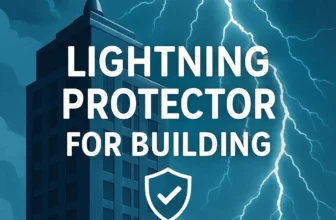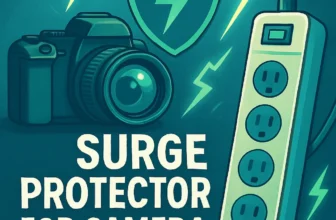Published By: Marc Edwards | Last updated on July 17, 2025 and reviewed by Editorial Team
- The False Security of Basic Power Strips
- Understanding the Invisible Threat to Your Electronics
- The Real Cost of Inadequate Protection
- How Smart TVs Differ from Traditional Electronics
- From Vulnerability to Security: The Protection Difference
- The Peace of Mind Premium
- Making the Right Choice for Your Entertainment System
- Moving Forward with Confidence
Discover how ordinary power strips are secretly damaging your expensive smart TV, and why proper surge protection is essential for extending your device’s lifespan and protecting your investment.
The living room goes dark.
Lightning flashes outside your window.
For a moment, everything is silent. Then, as the power returns, you hold your breath – will your $1,500 smart TV still work?
The screen flickers once, twice, then fills with color.
You exhale. Safe, this time.
But what you don’t see is happening inside your television – microscopic damage accumulating with every power fluctuation, silently shortening its lifespan. That basic power strip you’ve had since college isn’t just inadequate; it’s actively endangering the sophisticated electronics you’ve invested in.
Most homeowners remain unaware that their entertainment systems are constantly exposed to invisible power threats. The technology inside modern smart TVs has evolved dramatically, yet many of us still protect these sophisticated devices the same way we did our cathode-ray tubes from the 1990s. This disconnect between advanced technology and outdated protection creates a vulnerability that affects millions of homes.
The False Security of Basic Power Strips
That standard power strip under your entertainment center might provide multiple outlets, but it offers virtually no protection against the electrical anomalies that damage sensitive electronics. Many homeowners mistakenly believe any power strip provides surge protection – a dangerous assumption that leaves expensive equipment vulnerable.
A standard power strip is essentially just an extension cord with multiple outlets. It might have an on/off switch and possibly a circuit breaker that trips during extreme overloads, but these features protect against fire hazards, not the electrical issues that damage electronics.
The internal components of your smart TV – the microprocessors, memory chips, and display drivers – require stable, clean power to function properly and maintain longevity.
When power fluctuations occur, these sensitive components experience stress that accumulates over time. The damage is rarely catastrophic in a single event (unless during a major surge), but rather deteriorates performance gradually until failure becomes inevitable, usually just after your warranty expires.
Understanding the Invisible Threat to Your Electronics
Power quality issues extend far beyond the dramatic lightning strike. Your home’s electrical system experiences hundreds of minor fluctuations daily, most of which are too subtle to notice but potent enough to stress electronic components. These disturbances originate from multiple sources, many of which come from within your own home.
When major appliances, such as refrigerators, air conditioners, or washing machines, cycle on and off, they create small power fluctuations that ripple through your home’s electrical system. External factors add to this electrical noise – utility grid switching, nearby construction, or even your neighbor’s power tools can introduce disruptions that affect your home.
Modern smart TVs contain sophisticated microprocessors similar to computers, with components designed to operate within specific voltage parameters. When power deviates from these specifications, even momentarily, it forces these components to work harder, generates excess heat, and accelerates wear.
The TV’s power supply attempts to compensate, but without proper protection, it can only do so much.
This invisible stress manifests in various ways: intermittent performance issues, unexplained reboots, shortened lifespan, and eventually, complete failure. The frustrating aspect is that consumers rarely connect these problems to power quality, instead blaming the manufacturer for what they perceive as premature failure or poor build quality.
The Real Cost of Inadequate Protection
When we purchase a smart TV, we often focus on the upfront cost, but rarely consider the true cost of ownership. A quality television should provide years of service, but inadequate power protection substantially reduces this lifespan. The economics become clear when we examine the numbers.
Consider a $1,200 smart TV. With proper power protection, you might reasonably expect 7-10 years of service. Without it, power-related stress might reduce that to 3-5 years. The difference represents hundreds of dollars in premature replacement costs.
Furthermore, when electronics fail, they rarely do so in isolation – the same power event that damages your TV can affect your sound system, gaming console, and streaming devices simultaneously.
Beyond the equipment costs, there’s the inconvenience and frustration of dealing with failures, especially when they occur during important moments – the championship game, a long-anticipated movie night, or when entertaining guests.
Such disruptions have real emotional and social costs that extend beyond the financial impact.
The most insidious aspect of this problem is its gradual nature. Because damage accumulates over time rather than occurring catastrophically, consumers often fail to connect cause and effect. When a TV begins displaying problems after three years, few homeowners attribute it to the power strip they’ve been using since day one.
How Smart TVs Differ from Traditional Electronics
The vulnerability of modern smart TVs stems from fundamental differences in their design compared to earlier generations of televisions. Traditional CRT televisions contained relatively simple electronic components with higher tolerance for power fluctuations.
Their power supplies were designed with significant headroom to accommodate variations in household electricity.
In contrast, today’s smart TVs are essentially specialized computers with sophisticated operating systems, wireless connectivity, and high-resolution displays. They contain multiple microprocessors, memory chips, and specialized circuits that operate at extremely low voltages – often just 3.3 or 5 volts. These components require precise power regulation to function correctly.
Also, modern displays – whether LED, OLED, or QLED – contain millions of individual elements controlled by sensitive driver circuits. These technologies deliver the stunning picture quality we enjoy but at the cost of increased sensitivity to power anomalies. The dense circuitry and minimal spacing between components also make heat dissipation more challenging, further reducing tolerance for electrical stress.
The integration of “smart” features compounds this vulnerability. When your TV is constantly connected to Wi-Fi, receiving updates, and running applications, its processors are continuously active, even in standby mode. This persistent operation means the device is exposed to power quality issues 24/7, not just during active viewing.
From Vulnerability to Security: The Protection Difference
The transformation from vulnerability to security begins with understanding what adequate protection actually looks like. It’s not merely about having a surge protector – it’s about having the right surge protector with appropriate specifications for your specific equipment.
For a modern entertainment system centered around a smart TV, protection should include multiple layers. The foundation is a quality surge protector with sufficient joule rating, low clamping voltage (the level at which protection activates), and fast response time. For comprehensive protection, this device should safeguard all connections – not just power, but also coaxial cables, ethernet, and phone lines that can carry surges into your equipment.
Beyond surge protection, power conditioning provides additional benefits for sophisticated electronics. These features filter noise from the electrical line, ensuring your devices receive clean, stable power. This conditioning not only prevents damage but can improve performance – reducing interference that might affect picture quality, sound clarity, or wireless connectivity.
For those seeking maximum protection, a line conditioner or uninterruptible power supply (UPS) offers benefits beyond surge protection. These devices maintain stable voltage during brownouts or minor fluctuations and can provide backup power during outages, allowing for proper shutdown rather than abrupt power loss that can corrupt smart TV operating systems.
The Peace of Mind Premium
When we invest in quality surge protection, we’re purchasing more than electrical components – we’re buying peace of mind. Knowing that your expensive electronics are properly protected allows you to enjoy them without the nagging worry of vulnerability during storms or power fluctuations.
This peace of mind extends beyond the immediate protection.
Many quality surge protectors include equipment protection warranties, sometimes covering connected devices for up to $100,000. While these warranties come with specific terms and conditions, they represent the manufacturer’s confidence in their protection capabilities.
The psychological comfort of proper protection becomes particularly apparent during electrical storms or when power reliability is questionable. Rather than unplugging everything at the first rumble of thunder (often forgotten until it’s too late), you can continue enjoying your entertainment with confidence that your system is protected against electrical threats.
Making the Right Choice for Your Entertainment System
Selecting appropriate protection for your smart TV and entertainment system requires considering several factors beyond simply purchasing any product labeled “surge protector.” The right choice depends on your specific equipment, home electrical environment, and protection priorities.
First, assess the total value of the equipment you’re protecting. A basic surge protector might suffice for a secondary TV with minimal connected devices, but your main entertainment center deserves comprehensive protection proportional to its value.
If you’ve invested thousands in a premium smart TV, sound system, and gaming consoles, allocating a proportional amount to their protection makes financial sense.
Next, consider your home’s electrical environment.
Older homes, rural locations, or areas with frequent storms may experience more power issues, warranting higher protection levels. Similarly, homes with numerous large appliances or those with questionable utility power quality benefit from more robust protection solutions.
Evaluate the connections your system requires. Modern entertainment systems involve multiple pathways for surges to enter, including power outlets, cable/satellite lines, Ethernet connections, and even HDMI cables that connect multiple devices.
Complete protection addresses all these vulnerabilities, not just the power cord.
Finally, consider additional features that enhance protection and convenience. These might include properly spaced outlets to accommodate bulky adapters, USB charging ports, indicator lights that confirm protection is active, or remote monitoring capabilities in smart models.
Moving Forward with Confidence
Your entertainment system represents a significant investment – both financially and in the enjoyment it brings to your home. By giving it the protection it deserves, you ensure that investment continues to deliver value for years to come. The peace of mind that comes from knowing your expensive electronics are properly safeguarded allows you to focus on what really matters – enjoying the entertainment experience they provide.
Don’t wait for the next storm or power fluctuation to expose your vulnerability. Take action today to ensure your smart TV and entertainment system receive the protection they deserve. Your future self will thank you when your devices continue performing flawlessly long after inadequately protected electronics have failed.









